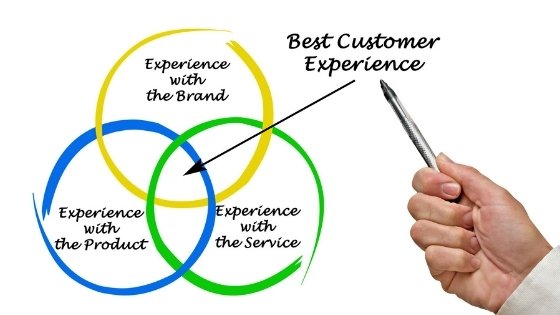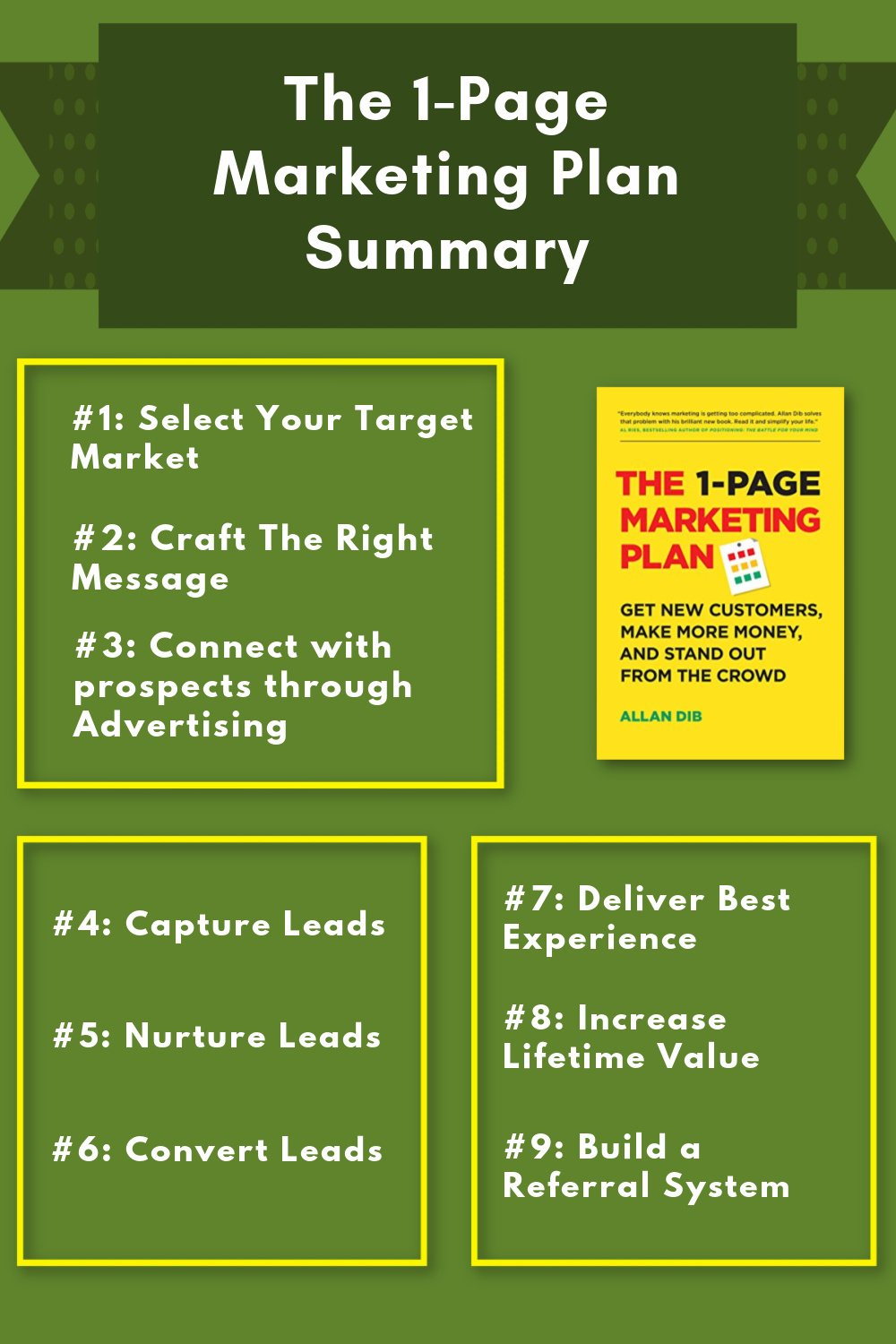Quick Summary: In The 1-Page Marketing Plan by Allan Dib, you’ll learn how to turn your cold prospects into customers. And then those customers into a tribe of raving fans using the power of Marketing.
[amazon box=”1989025013″ template=”horizontal”]
The 1-Page Marketing Plan Summary (PDF)
Step 1: Select Your Target Market

The very step in any marketing campaign is to decide who to market to.
Who are the people you’ll show your advertisement to?
Who will you serve?
For example: Apple makes iPhones, Laptops, etc.
So their target market consists of those people who are interested in buying electronic products.
But knowing that alone won’t help you in any way.
If you are a small business, then chances are you aren’t sure about your target market. It may be of small size in the beginning.
Most businesses make mistakes and never clearly define who is their ideal customer and who they are trying to sell.
So what’s a target market again?
In simple words, a target market is an ideal group of people who have similar problems or needs, which your business can fulfill.
Knowing the definition isn’t the hard part.
The hard part is:
How to find your target market?
But before we discuss that, let me tell you the benefits of having a target market.
People often think, “Why don’t just sell to everyone?”
Makes sense, right? Wrong.
At first, it looks like a common approach. For example, people stand in long lines to buy from Apple. So if they can sell to anyone, why can’t we?
The problem here is:
Apple is a big brand. And they have lots of money.
Their budget isn’t like any other business.
It’s huge!
So if your target market is the entire earth, you better make sure that you have more wealth than Jeff Bezos.
Fortunately, you don’t need to.
I’m assuming that you’re a small business owner or someone thinking about starting a business.
As a small business, you don’t have a huge budget to pay for all the marketing Ads, right? Therefore, it’s kind of impossible to do mass promotion.
Having a target market helps you target your ideal customers and not just anyone interested in what you do.
By defining a niche market, you become more appealing to your ideal prospect.
That too, by paying less!
It saves you a lot of effort, time, and other such resources.
Another advantage of having a target market is that you become a specialist in your industry. And according to the author, a specialist is paid more than a generalist.
Any advice given by a specialist is more trusted over a generalist.
See how important it is to limit yourself in the beginning and serve only your target market?
Now that you know why selecting a target market is important, let’s find out how to select one.
To do that, ask yourself these questions:
- How much value do you get after serving your target market? If there isn’t any profit in serving a market, then you should find another. The reason is simple. A business can’t survive without making any profits or money. If you aren’t getting paid in the end, you won’t be able to serve anybody.
- Do you enjoy serving this market? Money is important. But it shouldn’t be your only motivation. You should be genuinely interested in serving a market. And the people you wish to serve should also be interested in what you do. Remember, you have to achieve your personal goals as well as help other people achieve theirs.
Step 2: Craft The Right Message
One major goal of marketing is to deliver the right message to the right people.
Phrased in other words:
What are you trying to say?
And for your target market, it means:
Why should they even listen to you?
The second one makes more sense, doesn’t it?
Wondering why? Because it’s more about the people you wish to serve.
And that’s why you must choose the right message and deliver it only to those who might be interested in listening to what you’re trying to say or wish to say.
Now the question is:
How to craft a compelling message?
The author has shared various tips in this book that might help you craft the right message for your target market.
The easiest way to do that is:
Be clear.
You should put more emphasis on being clear.
For example, most businesses make their ad copies too fancy. Which looks nice, of course, but hardly gets conversions.
How your ad looks matter. Agreed!
But it shouldn’t be at the cost of clarity and effectiveness.
Another tip is to make your ad copy more personalized and focused.
Your ad shouldn’t ever be focused only on what you sell or your brand.
It should shout, “What’s in it for them?”
The author says that you need to keep experimenting with your ad copy. The reason being it’s rare to get it right the very first time.
A copy becomes automatically compelling if it has a compelling offer.
Let’s learn a few tips that help you create an irresistible offer.
One of the best pieces of advice is to hit emotional trigger buttons inside the minds of your target customers.
For instance, you should hit emotions such as fear, greed, love, pride, etc.
Allan says that humans are bags of emotion. To connect with them at a deeper level, you need to hit at least one of their emotions.
One brilliant tip to optimize your offer to tell exactly who will benefit from your product or service.
Doing so would instantly develop trust and credibility, which is essential to make a strong impact with your message.
How you name your product or service also adds to your message.
The author suggests having a clear name that instantly tells the customer what your product is about and how it can help them.
For example:
A simple old name like “All Car Service” is far better than a clever name like “Dream Cars.”
Naming is super important. Once you put up a name, it stays the same for years. And if you do it wrong, you always regret it.
It’s bad for both you and your customers.
You regret it. And your customers get confused.
And both of these things may hurt your business.
But some things go against conventional wisdom.
For example, look at the name “Google.”
At first glance, it’s impossible what do they do, right?
Even today, most people don’t know the meaning of the word “Google.”
They compensated for this by putting so much money into their marketing. But they didn’t run Ads. They created an ecosystem.
We’ll talk about it some other day.
The catch here is:
If you try to replicate what Google did with its name, chances are, it’ll hurt your business.
Although the author says that you shouldn’t be clever with your naming, you need to consider many other factors.
Don’t get lost in all the shiny tactics!
Remember, your main goal here is to deliver a clear message to your target prospect. And eventually, turn him into a customer, and then a raving fan.
Step 3: Connect with your prospects through advertising
Most business associate advertising with Brand Awareness.
But the author says that it’s a mistake.
Let me explain.
Most small business owners try to copy what the big brands do. For example, when they see that big brands run Ads on TV or placing hoardings and banners on the streets, they try to replicate it.
Result? Waste of money.
Why? Simple, because big brands have different goals, unlike small businesses.
Mindlessly copying them hurts your business.
So what’s the right way?
The right approach is not to run brand awareness Ads unless you are a big brand. Instead, run targeted ads.
Again, most small business owners try to sell directly through their Ads.
That’s a mistake, too, says the author.
The truth is:
People don’t buy from a company unless they like it or trust it enough.
And if they do, they usually judge your offer based on pricing, which is again a terrible position to be in.
As a small business owner, you need to be strategic.
Running awareness campaigns in your initial days won’t help you much.
Your goal during your initial days should be to build rapport and a relationship with your target customer.
You have to educate them about what you can do for them or everything they need to know so that they trust you and like you.
You might have heard “Jab. Jab. Jab. Right hook.”
It’s based on the same idea.
I know it’s tempting to sell on your first meeting with your customer. But don’t be annoying.
Don’t appear like a pushy salesperson.
Appear as an expert first. Sell later.
Selling is about helping your customers.
And you can only help them if you know them and know their frustrations.
So how to achieve all this?
Through email marketing.
Yes, that old-fashioned way.
Trust me, it still works!
First, why email?
Because email is an asset that you own.
Those thousands or even millions of followers on social media platforms might make you feel on top of the world.
But the ugly truth is:
You don’t control them.
Phrased in other words: They are not yours!
It’s like building a castle on somebody else’s land.
Sound like a nightmare, doesn’t it?
Emails too come with their own set of challenges.
The major advantage of sending emails is that you get to develop a strong relationship with your customers.
Plus, you can put your emails on automation.
There are disadvantages of using emails too. For instance, your recipients may spam you or even blacklist you.
You also need to face several challenges like:
- Getting your emails delivered.
- Getting your emails open and read.
- Getting your customers to take action based on what you’ve written inside your email.
It’s a lot of work, right?
Also, just because you own your email list, you have other challenges to deal with.
The truth:
You own your list. But you don’t own people.
People can choose out of their will.
It’s not discussed in the book. But I feel that I have to let you know the entire concept.
Anyway, the pros of using emails outweigh the cons.
Just remember this line:
Get the right message to the right market through the right medium.
This line will help you stay focused while running campaigns and avoid shiny object syndrome.
Step 4: Capture Leads

So you just read about how you can develop a bond with your customers by sending emails.
The question is:
How will you get those emails?
They won’t fall from the sky, right?
It’d be pretty amazing if they did. But let’s not wait for that to happen.
Moreover, you don’t need just any emails. You need the leads of your target market.
The point is:
You need a system to collect those leads.
You should be able to contact those people who are interested in doing business with you, says the author.
Most people do it by putting up a lead generation form on their website.
It doesn’t matter how you get those leads, but you must ensure that you’ve thought of a system that constantly fills your database with new leads.
You should be able to visualize the entire process.
And implement it!
Make the right goals for your business.
Don’t pick up any fancy technique just because some guru is advising you.
Your business deserves your attention.
Also, don’t give in to the temptation of selling right from your advertisement.
Set up a process or a system that accepts new leads and then turn those leads into your fans who buy repeatedly buy from you.
Continuing on the same idea, let’s move on to the next step.
Step 5: Nurture Leads
The next step is to nurture those leads.
Now you’ll learn why money is in the follow-up.
You’ll learn exactly what type of mindset you should cultivate.
The author suggests that you think like a farmer. Not like a hunter.
Let me explain.
A hunter goes for a hunt every single day.
And guess what happens? Only two things are possible:
Either he gets a hunt, or he doesn’t.
When he doesn’t get a hunt, he feels sad. And when he gets a hunt, he feels happy.
That’s the typical way of doing business. Most businesses work exactly like that.
Either they get a customer, or they don’t.
But when you act like a farmer, you own land. Then sow seeds. Then water them consistently.
And eventually, eat the fruits of your labor for a long time.
Best businesses are those that think long-term.
Example: Google thinks in decades. Apple thinks in terms of years. Even centuries.
What can you learn from this as a small business owner?
You need to nurture the leads, which you have captured.
When you try to sell right from your advertisement, you run the risk of losing a potential prospect for a lifetime.
But when you capture leads and nurture them, you get a customer with enormous lifetime value.
You can keep nurturing your lead until it’s ready for a sale.
The author says that most business owners give up after 3-4 follow-ups.
While smart business owners understand that it takes a lot more than we think, so they keep nurturing those leads, they remain patient.
In fact, it’s good news. Because if you remain patient, other business owners will give up. In short, there will be less competition for you.
The author related lead nurturing with watering plants.
You can’t just water a plant 2-3 times and then expect fruits.
That would be pointless.
You need to water your plants until they grow up, turn into a tree, and bear fruits.
Right?
I guess you got the point.
Step 6: Convert Leads Into Customers
This is where you make money.
The author says that money is like oxygen to your business.
It’s simple:
If you don’t have money to pay your bills, you’ll struggle for some time. And then, eventually, your business will die.
Don’t worry, since you’re reading this, that tragedy won’t happen with you.
You have the ultimate power of marketing at your disposal now.
If used in the right way, it can bring you a fortune. (*Conditions applied)
Sales is a delicate matter when it comes to business.
Be too pushy, and your prospect will be gone forever.
Be an educator or helper, and you’ll be welcomed and thanked.
It may sound weird, but that’s the truth.
First, let me break a myth for you.
The author says that it doesn’t mean that your target market will buy from you just because you exist.
You need to build a sales system to make sales.
Let that idea sink in for a moment.
Ever had the feeling, “Why are people not buying from me?”
That’s because you’re not doing your marketing right.
One of the most overlooked factors while making conversions is trust.
People forget to build trust before asking for a sale.
How to do that?
You need to give trust signals to your prospects.
Here a few ways:
- Use a professional email address like xyz@companywebsite.com (instead of timmy@gmail.com)
- Provide a 30-day risk-free reversal guarantee.
- Have a toll-free customer care number.
- Use testimonials for social proof.
Another tip that the author gives is to have a standard and premium version of the same product or service.
The reason is simple: a few of your customers or fans would be interested in paying much more if you provide them more value.
Again, a high-ticket product is always a good source of money.
Even if 1% of your existing customers buy that product, you get a huge profit.
Sales are where the businesses make their profits.
The author advises that a business owner should clarify to its employees that every person is a salesman. And provide incentives to those who bring more sales.
A business owner should encourage its employees to help make more sales regardless of what department they are in.
This one simple change can bring a marginal difference in your total revenue.
Also, to increase your sales, you must reduce the friction between your customer and sales. In other words, a customer shouldn’t face any difficulties while making a payment or getting information about the desired product.
If you have to sell a high-ticket product, make sure you are providing a monthly installment plan.
The psychology behind that is, our brains aren’t that good to measure the advantage or disadvantage with time.
People also get scared to give lumpsum money.
When they pay on a monthly installment, it feels much safer.
These might look like little things, but these subtle strategies could grow your revenue numbers.
Step 7: Deliver A World-Class Experience

Most business owners think that once they have completed a sale, it’s over.
Nothing could be further away from the truth.
Just look at Apple. And see how they deal with their customers.
Well, I haven’t bought any Apple products. But from my knowledge, they are known for their support and user experience, right?
Why do they focus on providing a great customer experience?
Shouldn’t they just close the sale and forget about their customers? Absolutely not.
If you’re not providing a world-class experience to your customers, you’ll lose out on the lifetime value.
Providing a great consumer experience helps you increase the customer’s lifetime value.
It helps you to get repeat customers.
Which is better: A one-time customer or a customer that buys from you again and again?
The second one, right?
Even if you have a small customer base, you’d still make a great profit in the long-run.
By providing a great experience, you also position yourself as a leader in your industry, which again improves your brand value.
The author says that you should even help your customer to achieve the result they want.
For instance, if you sell a weight-loss product, you should help your customers to actually lose their weight. Thinking that it’s only their responsibility may harm your brand image.
If your customer thinks that your product wasn’t good, he won’t buy from you again. What will he do then? He’ll go to your competitors.
And in the worst case, if one of your competitors helps them achieve the desired result, your brand image will suffer in the eyes of your target market.
That would be terrible, right?
These days, you can use technology to improve your customer experience. And even put it on automation.
Those days are gone when you had to do everything manually.
But yes, you will have to use paid tools at some point.
Even the author recommends that you use paid tools for your marketing. Reason? They are more flexible and secure.
By using paid tools, you’ll able to build a business with systems.
One major benefit of creating systems in your business is that your business becomes highly sellable.
Ask yourself this question:
“Can my business run without me?”
If not, then you need to build systems in your business.
If yes, then congratulations. You’re far ahead of most business owners. Now you need to improve the existing systems wherever necessary.
Step 8: Increase Your Customer’s Lifetime Value
If you’ve read everything above, you realize how important increasing your customers’ lifetime value is. Right? I’m assuming you read everything properly.
Even if you didn’t read the entire thing, it’s fine. You’ll catch up here!
A customer’s lifetime value is how much he can pay you during his entire life or until he dies.
If a customer buys once from you but never buys again. Then that customer’s lifetime value would be zero.
On the flip side, if your customer loves your products, he’ll keep on buying over and over again. That customer would have a high lifetime value.
Now the question is:
How to increase a customer’s lifetime value?
The author has shared a few tips in this book.
And I’m going to give you a brief idea about that.
There are mainly two methods:
- Sell more
- Increase prices
Let’s talk about increasing prices by selling more.
You can use subscription models to make your customers buy more frequently.
Building a subscription-based business is out of the context of this summary.
(Recently, I published the summary of The Automatic Customer by John Warrillow. Make sure you check that out to learn more.)
When you sell more or sell more frequently, you increase your revenue.
Another strategy is to increase your prices.
When you charge more price for your existing products, you instantly get a raise in your revenue.
But then, you also need to make sure that you’re giving a genuine reason for doing so.
For instance, you can increase the value you are providing.
One counterintuitive tip that the author gives is that you fire the problem customers.
Not all customers are good for your business.
Most business owners think:
The more customers, the better.
But there is a change.
If you believe the author, then:
The more the good customers, the better.
Or if you’ve lesser bad customers, it’s even better.
You shouldn’t cling to those customers whose only job in their life is to give you trouble.
Of course, there will be genuine complaints too.
But there are always a few people who won’t agree with whatever you do. They exist to give you trouble. That’s the harsh reality.
So the sooner you get rid of bad customers, the sooner you will be able to claim back your time and use it to provide better service to your good customers.
Your good customers deserve far more attention than your bad customers.
The caveat is:
People think of all complaints as a nuisance. And never address them.
Don’t be like that.
Always address issues within your business.
Do whatever you can to provide an amazing experience to your genuine customers who love your products and appreciate the value you provide.
When you do that, you increase the lifetime value of your customers.
It can also help you get more referrals.
Which takes us to the next step.
Step 9: Build A Referral System
What does a referral mean in business?
A referral happens when a customer likes your product/service and recommend it to someone he knows.
That’s simple, right?
Why does a business owner need referrals?
Simple, you get more customers through referrals.
When a person recommends your product/service to another person, your perceived value is enhanced in that person’s eyes.
Plus, since people recommend to their friends, the person to who your product is referred probably belongs to your target market.
So, if you have a referral system in place, you get a continuous flow of targeted leads.
Pretty awesome, huh?
So what’s the problem here? Why do most businesses hardly build a referral system?
The author says that people usually feel shy while asking for referrals.
They feel like beggars!
But it’s the wrong mindset.
Why? Because by not asking for referrals, you’re leaving so much value on the table.
In fact, if you see modern businesses these days, they make a lot of profit by using the power of referrals.
Consider affiliate marketing. People pay their affiliates to bring them leads.
And what do affiliates do? They recommend or refer to products or services.
So if you want to build a referral system, you can give incentives to those who bring you qualified leads.
That way, people would love to refer you to their friends or anyone who might be interested in doing business with you.
There are so many other strategies and tips I haven’t covered in this summary.
If you want to learn all the tips and tricks, you’ll have to read the book.
The 1-Page Marketing Plan by Allan Dib Summary Infographic

The 1-Page Marketing Plan Review
[amazon box=”1989025013″ template=”horizontal”]
This is one of the best books ever written on Marketing.
I was amazed by how the author fit the complex marketing concepts into one single page.
Marketing isn’t simple if you go by the traditional methods.
But if you focus on a few core concepts and cut down on the shiny tactics, you can make marketing pretty simple.
The best part is:
When you simplify what you do, you increase the probability of implementing it.
For example, if there is a fancy tactic, which is hard to implement, chances are you’ll end up wasting your time studying that tactic and hardly get the desired result from it.
Focus on the core elements of marketing.
That’s why, I think, the author created this book.
He wants you to focus on what’s important rather than chasing after marketing hacks.
Don’t think twice.
Buy this book. And read it.
I would say this book is an absolute must-read for marketers.
One of the best books I’ve ever read on Marketing.
Cheers to the author for creating such an amazing book.
After reading this book, you’ll have the right mindset to market your business products or services.
You’ll be able to attract the right customers and sell them until they die.
Now it’s your turn!
I guess you enjoyed The 1-Page Marketing Plan Summary.
Now you tell me:
How are you going to market your products now?
Do you even have a business?
If you don’t, what different will you do than other marketers while building your business? (Assuming you’re a wannabe entrepreneur)
Either way, let me know your thoughts in the comments below.
You’re welcome to share your expert opinion if you have any experience in the field of marketing.
And as always, don’t forget to share this summary with your friends who might benefit from it.
